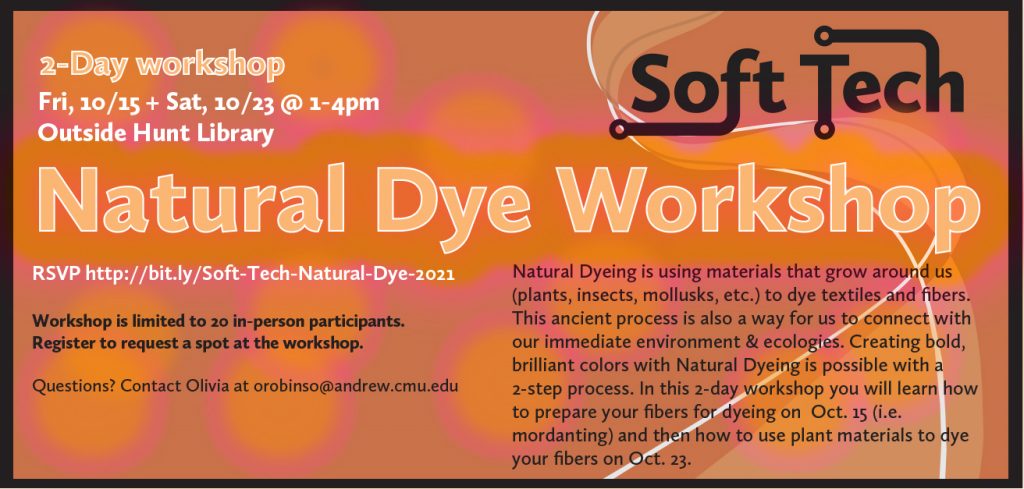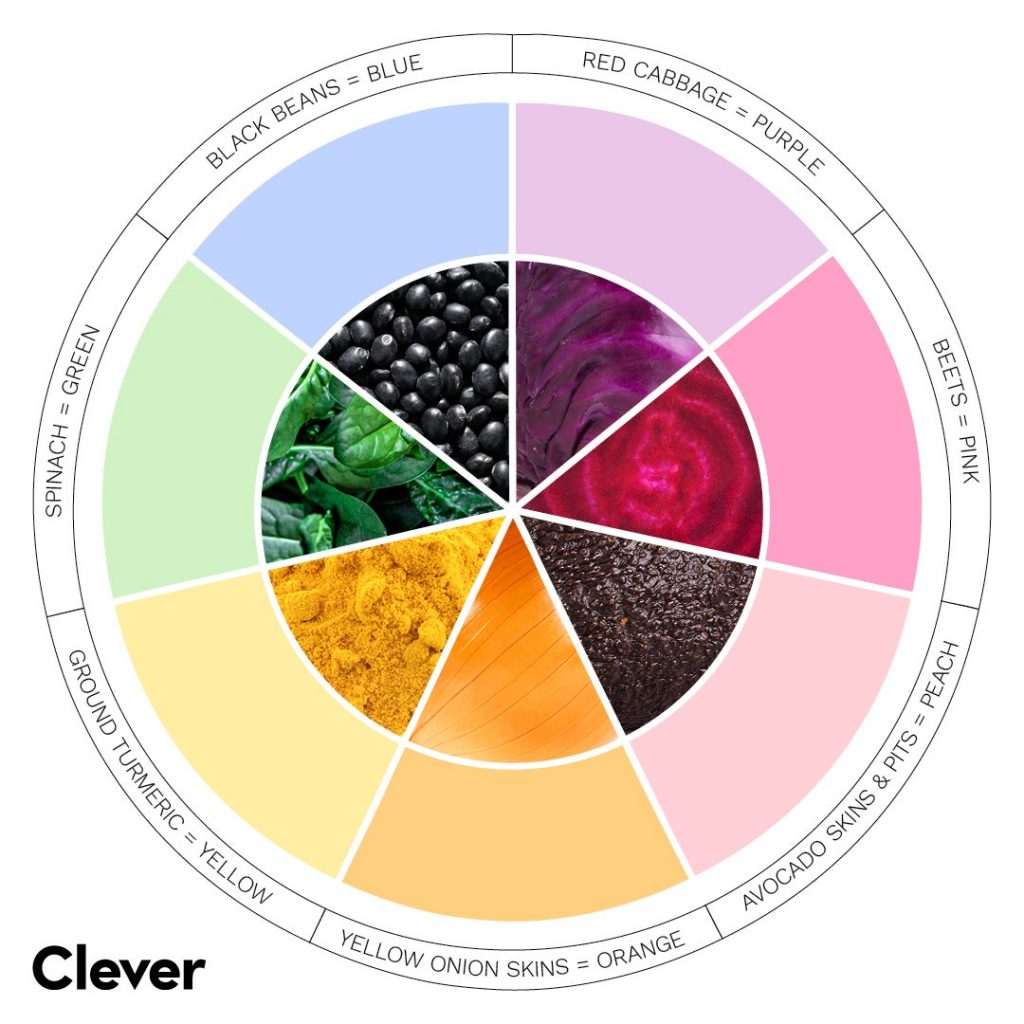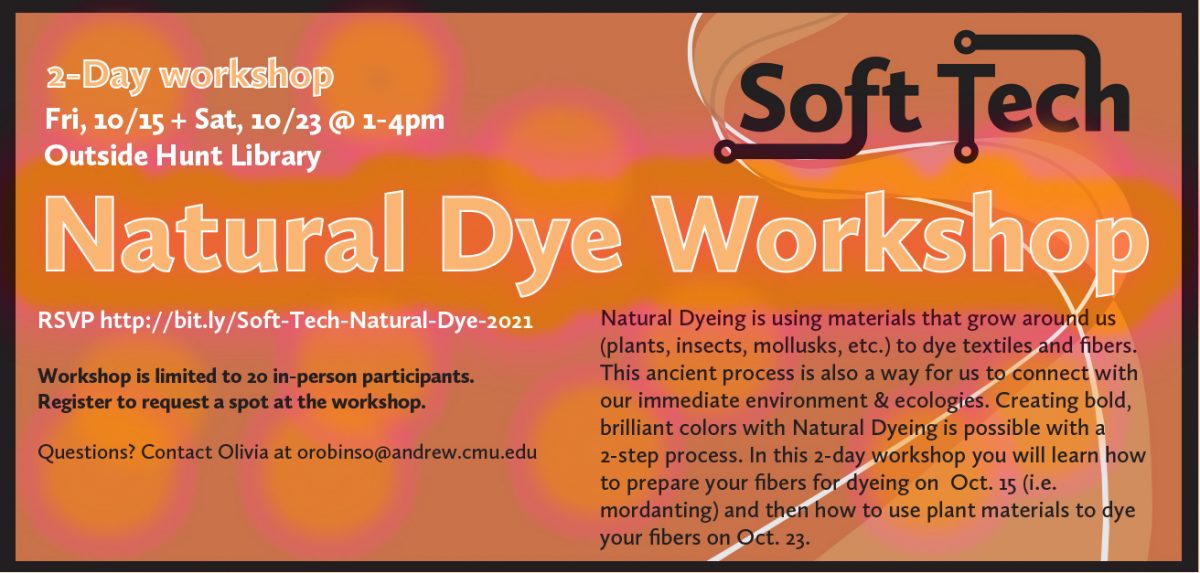
Natural Dyeing is using materials that grow around us (plants, insects, mollusks, etc.) to dye textiles and fibers. Getting bold, brilliant colors with Natural Dyeing is possible with a 2-step process. In this 2-day workshop you will learn how to prepare your fibers for dyeing on Oct. 15 (i.e. mordanting) and then how to use plant materials to dye your fibers on Oct. 23.
- When: Friday, Oct. 15, 2021 @ 1PM-4PM and Saturday, Oct. 23 @ 1-4pm
- Where: Outdoors, near Hunt Library
- Register Here
Students enrolled in Intro to Textile media have a spot in the workshop. To claim your spot in the workshop, register by Oct. 12.
We will provide fabrics for dyeing, but you can also bring one item to dye. Your item should be small, such as: a knit hat, scarf, swatches of fabric, skein of yarn, etc. Natural dyeing works best on natural protein fibers. If you bring an item, it needs to be made of animal fibers, such as: wool, alpaca, silk, cashmere, angora, etc. (Thrift stores often have lovely, old sweaters made of such materials.)
Since we have a limited number of spaces for participants, please let us know as soon as possible if you signed up but cannot attend, so we can let in another participant.
Looking forward to seeing you at the workshop!
A Little Bit about Natural Dyeing
Vibrant colors can be achieved using the right techniques that have been evolving since the Neolithic Period. Fabric dying can be done with a wide range of natural materials that can be found right outside your home as well as certain byproducts from food.
The image below shows a Peruvian artisan alongside dyed yarn created from alpaca wool. The article linked below describes the different materials used to dye the fibers as well as some techniques that used by the artisans.

In our workshop we will be using logwood, madder root, turmeric, marigolds, and a few other plants to color our fabrics purple, red and gold. These are all traditional dye stuffs used by humans in different parts of the world.
But we are not limited to these items, they are just ones that are very rich in color and very reliable. If, after the workshop, you want to keep experimenting, you can use local items growing around you for dyeing as well. Even food can be used for dyeing! The key to finding a good food to dye with is knowing which foods contain lots of tannin. This is important to achieve a stronger effect. Tannins create the bitter mouthfeel that results from eating foods such as dark chocolate or grape skins. This bitterness come from the plant’s defense mechanism to keep from getting consumed by animals. In dying, tannin is important.
Here are some examples of food products that dye can be extracted from: beet root, avocado seed and peel, coffee grounds, turmeric, pomegranate skins, acorn, oak, rhubarb, tea, walnut, cranberry, cacao, grapes, cranberries, strawberries, blueberries, apples, apricots, peaches, mint, basil, rosemary, black beans, onion skins, and so many more!
Foods as Natural Dye stuffs

Red Dyes: https://www.thesprucecrafts.com/make-natural-fabric-red-dyes-2145745
Orange Dyes: https://www.thesprucecrafts.com/make-natural-orange-dyes-for-fabric-2145746
Yellow Dyes: https://www.thesprucecrafts.com/make-yellow-natural-fabric-dyes-2145748
Green Dyes: https://www.thesprucecrafts.com/make-organic-natural-fabric-dyes-green-2145742
Blue Dyes: https://www.thesprucecrafts.com/make-natural-fabric-blue-dyes-2145738
Purple Dyes: https://www.thesprucecrafts.com/make-natural-fabric-purple-dyes-2145994
Black Dyes: https://www.thesprucecrafts.com/make-organic-natural-black-dyes-2145737
